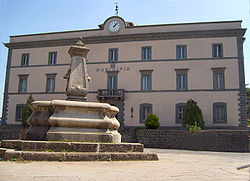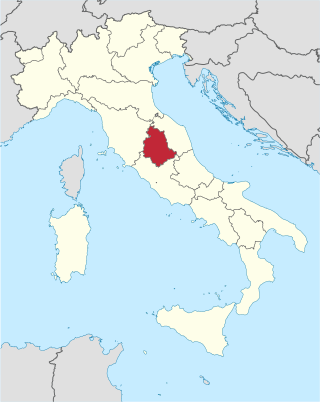
Umbria is a region of central Italy. It includes Lake Trasimeno and Marmore Falls, and is crossed by the Tiber. It is the only landlocked region on the Apennine Peninsula. The regional capital is Perugia.

Orvieto is a city and comune in the Province of Terni, southwestern Umbria, Italy, situated on the flat summit of a large butte of volcanic tuff. The city rises dramatically above the almost-vertical faces of tuff cliffs that are completed by defensive walls built of the same stone.

The province of Terni is the smaller of the two provinces in the Umbria region of Italy, comprising one-third of both the area and population of the region. Its capital is the city of Terni. The province came into being in 1927, when it was carved out of the original unitary province of Umbria.
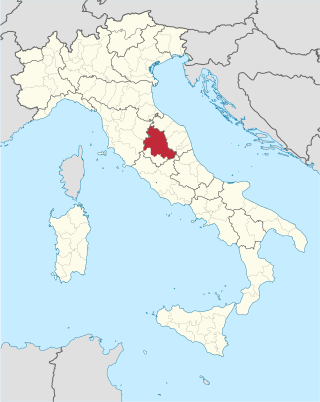
The province of Perugia is the larger of the two provinces in the Umbria region of Italy, comprising two-thirds of both the area and population of the region. Its capital is the city of Perugia. The province covered all of Umbria until 1927, when the province of Terni was carved out of its southern third. The province of Perugia has an area of 6,334 km2 covering two-thirds of Umbria, and a total population of about 660,000. There are 59 comuni in the province. The province has numerous tourist attractions, especially artistic and historical ones, and is home to the Lake Trasimeno, the largest lake of Central Italy. It is historically the ancestral origin of the Umbri, while later it was a Roman province and then part of the Papal States until the late 19th century.
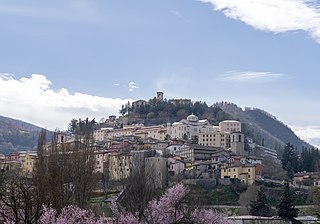
Cascia is a town and comune (municipality) of the Italian province of Perugia in a rather remote area of the mountainous southeastern corner of Umbria. It is about 21 km from Norcia on the road to Rieti in the Lazio (63 km). It is also very close to Terni.
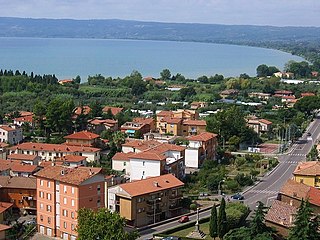
Bolsena is a town and comune of Italy, in the province of Viterbo in northern Lazio on the eastern shore of Lake Bolsena. It is 10 km (6 mi) north-north west of Montefiascone and 36 km (22 mi) north-west of Viterbo. The ancient Via Cassia, today's highway SR143, follows the lake shore for some distance, passing through Bolsena. Bolsena is named "the city of the Eucharistic miracle" from which the solemnity of Corpus Domini had been extended to the whole Roman Catholic Church.
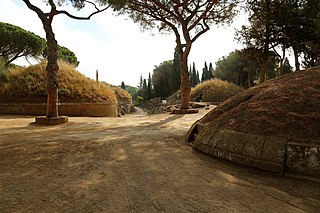
Cerveteri is a comune (municipality) in the Metropolitan City of Rome Capital, in the Italian region of Lazio. Known by the ancient Romans as Caere, and previously by the Etruscans as Caisra or Cisra, and as Agylla by the Greeks, its modern name derives from Caere Vetus used in the 13th century to distinguish it from Caere Novum.

Acquapendente is a city and comune in the province of Viterbo, in Lazio (Italy). Acquapendente is a centre for the agricultural production of vegetables and wine, and has a tradition of pottery craftsmanship. Its frazione of Torre Alfina is one of I Borghi più belli d'Italia.

Orbetello is a town and comune in the province of Grosseto (Tuscany), Italy. It is located about 35 kilometres (22 mi) south of Grosseto, on the eponymous lagoon, which is home to an important Natural Reserve.
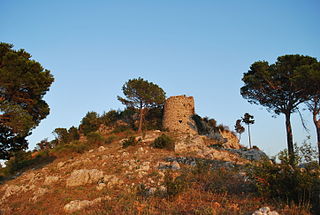
Castel San Giorgio is a town and comune in the province of Salerno in the Campania region of south-western Italy. In 2011, it had a population of 13,411.

Castellina in Chianti is a comune (municipality) of c. 2,800 inhabitants in the province of Siena, in the Italian region Tuscany, located about 35 kilometres (22 mi) south of Florence and about 15 kilometres (9 mi) northwest of Siena. It is part of the Chianti Hills, between the valleys of the Arbia, Pesa and Elsa rivers.

Castel Viscardo is a comune (municipality) in the Province of Terni in the Italian region Umbria,

Ferentillo is a comune (municipality) in the Province of Terni in the Italian region Umbria, located about 60 km southeast of Perugia and about 12 km northeast of Terni. The comune, located in the valley of the Nera, is divided by the river into the burghs of Matterella and Precetto.

Ficulle is a comune (municipality) in the Province of Terni in the Italian region Umbria, located about 40 km southwest of Perugia and about 60 km northwest of Terni.

Monteleone d'Orvieto is a comune (municipality) in the Province of Terni in the Italian region Umbria, located about 35 km southwest of Perugia and about 60 km northwest of Terni. It is one of I Borghi più belli d'Italia.
Porano is a comune (municipality) in the Province of Terni in the Italian region Umbria, located about 50 km southwest of Perugia and about 45 km northwest of Terni. As of 31 December 2004, it had a population of 1,867 and an area of 13.5 km2.
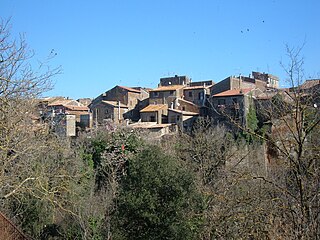
Barbarano Romano is a comune (municipality) in the Province of Viterbo in the Italian region of Latium, located about 50 kilometres (31 mi) northwest of Rome and about 20 kilometres (12 mi) south of Viterbo.

Borgo Velino is a comune (municipality) in the Province of Rieti in the region of Latium, Italy. It is located about 70 kilometres (43 mi) northeast of Rome and about 15 kilometres (9 mi) east of the town Rieti. It has an area of 17.3 square kilometres (6.7 sq mi), and as of 31 December 2010 it had a population of 1,004. Until 1927 Borgo Velino was part of the province of L'Aquila in Abruzzo. It is located near the site of a pre- or early-Roman Sabine village named Viario. Rare ruins of this ancient village, now occupied by a cultivated field, were found near a standing medieval tower. Borgo Velino is the birthplace of Giulio Pezzola, a notorious outlaw of the 17th century.

Castel Sant'Angelo is a comune (municipality) in the Province of Rieti in the Italian region of Lazio, located about 70 kilometres (43 mi) northeast of Rome and about 12 kilometres (7 mi) east of Rieti.

Poggio Mirteto is a comune (municipality) is situated in the Tiber Valley area of the region of Latium, Italy. Administratively Poggio Mirteto is in the province of Rieti and geographically this municipality is about 45 kilometres (28 mi) northeast of Rome and about 20 kilometres (12 mi) southwest of Rieti.
